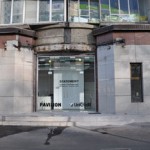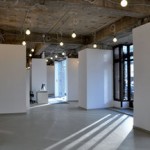Adriana Mereuta: UNICREDIT PAVILION Contemporary Art and Culture Centre, Bucharest
Photo: Ioana Nitu
In a capital in which art spaces tend to raise at the level of a rather undeveloped town, any new such insertion turns into an event. But UNICREDIT PAVILION is an event even beyond this sad context. And that because, first of all, it is not about a new gallery, but an independent contemporary art and culture centre – an operation of a new and strong identity (including an architectural one). The centre is the third stage of a programme initiated by Razvan Ion and Eugen Radescu, starting with the PAVILION Magazine and going on with the Bucharest Biennale. The founders of the centre took on the social and political element of art and wished the pavilion be a place meant for research and production and not a merely passive exhibition of local works. That is why the pavilion is not simply located somewhere in the town but it actually tries to be a place adequate for reflection, possibly action too, on the city and the society.
Except hosting art events and discourses, the centre also has an information point made of a Contemporary Art Archive (set by Lia and Dan Perjovschi) and a Pavilion Resource Room (a non-archive set by Razvan Ion and Eugen Radescu). Both are completely accessible and in constant progress, being thought as working and communication tools. The centre is completely autonomous, being supported by UniCredit Tiriac Bank, which also provided the space previously used by one of the bank’s branches.
The place seems totally fit for the identity of the centre. It is first about a central position, a high visibility and easily accessible location (which makes us reflect, for instance, at what the National Museum of Contemporary Art has to face). And secondly, an area meant for interactions: a historical area over which a totalitarian project came – the concrete curtain set by Ceausescu’s blocks – and then, during the transition, the insertion of a centre of political power (the government headquarters) and a typical development for the wild capitalism of the transition. Well, the centre does take on such neighbourhoods and this general logic productively: it highlights and expresses its openness via all possible means and accepts the cohabitation with neighbours and historical layers.
In today’s Romania, individual interventions in large buildings take their own frame usually, and they sort of arrange that rather autistically. Be it about ground floor shops or the closing of balconies of people’s apartments, each intervention becomes a piece of a disassembled jigsaw. The current project turns this situation into a means of architectural expression. The resulted part of the façade keeps both the deteriorated sections of the original building, as well as marks of the previous commercial setting to which it counterposes a precise and cold insertion of completely glazed walls: not only a façade for the interior, but the expression of an attitude. Inside, the intervention is actually about a radical cleaning of all existing compartments and finishings. The concrete structure stayed, and is apparent in the area of the ceiling, over which thin plasterboard divisions and the lighting system overlap vertically. Thus, a strong architectural expression manages to avoid a conflict with the neutrality needed for the functionality.
The information space containing the two archives, the key element of the programme, is also the main area of the pavilion; a permeable and fluid section which takes part in the surrounding space. For the future, mobile partitions are planned at both ends to allow educational activities with various partners. When those areas are closed, the information point will turn, by comparison, into the widest area of the compound, a space to welcome and reshuffle visitors. Actually, the whole setting takes on the process and progress of an institution, trying to imprint a powerful image without blocking future options and diverse approaches.
UNICREDIT PAVILION is an implant of a public and challenging programme into a context marked by highlighting power and trade; an architectural gesture to go beyond the exotic and the well-known conformism so typical for a large part of the local production. And this makes it a lot more remarkable than the mere scale of the intervention would normally allow it.



